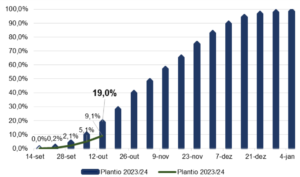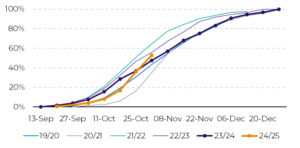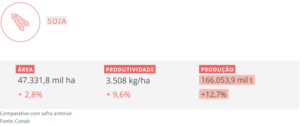The importance of the sowing window for Brazilian soybeans
Learn about the soybean sowing window, its importance in grain quality, how the Brazilian crop is doing this year, Conab data and more.
The soybean sowing window is the recommended period for planting the crop in Brazilian plantations, determined by the climatic and agronomic conditions of each region. This calendar is essential for plant development, crop productivity and grain quality.
In this article, we’ll talk about its importance, how the dates are set, as well as data on the planting of Brazilian crops for the 2024/2025 harvest. We invited expert Ignacio Espinola, Market Intelligence Analyst at Hedgepoint, to talk about the topic. Read on and enjoy!
The role of the soybean planting season
The planting calendar allows the crop to benefit from a more favorable growing cycle, especially in terms of rainfall and temperature. “The aim is to maximize the productivity of Brazilian soybeans, as well as minimizing the risks of climatic stress, such as drought or frost,” says Ignacio Espinola.
According to the Ministry of Agriculture and Livestock (MAPA), sowing dates are set according to technical data and suggestions sent in by Brazilian states. Among the variables analyzed are:
● Climatic conditions in each region
Rainfall, temperature and soil moisture data are checked to facilitate germination and initial plant growth;
● Agricultural cycle
Soybeans have a life cycle that varies from 90 to 150 days. The choice of period is analyzed to avoid the plantation facing adverse weather conditions at the end of the harvest.
● Agricultural zoning
Brazil’s Agricultural Climate Risk Zoning (ZARC) determines the recommended sowing periods according to the climate risk of each region.
● Local agronomic factors
The variables in each region of Brazil that can influence soybean quality are analyzed: soil type, altitude, production history, etc.
 “Planting outside the recommended window can affect the yield of soybean crops. The crop can face adversities such as reduced water supply and exposure to frost or drought,” adds the Hedgepoint expert.
“Planting outside the recommended window can affect the yield of soybean crops. The crop can face adversities such as reduced water supply and exposure to frost or drought,” adds the Hedgepoint expert.
Ignacio also points out that these climatic conditions can reduce the quality of the beans and increase the likelihood of pests, affecting their commercial value. With lower prices, the entire Brazilian soybean market is affected, which influences exports and the national economy.
Sowing calendar for the 2024/2025 soybean crop
In May of this year, the Ministry of Agriculture and Livestock published the soybean sowing calendar. The specific dates vary according to region and can be found below:
- Midwest: early October to mid-November;
- outh: between October and December;
- Southeast: mid-October to November;
- Matopiba (Maranhão, Tocantins, Piauí, Bahia): between the end of November and the beginning of January.
Check the specific dates directly on the MAPA website.
Delay in soybean planting is recovered in Brazil
Due to the dry weather, the 2024/2025 soybean harvest in Brazil began with a delay in planting. Conab (National Supply Company) surveys show that the start of sowing was slower than in previous years because the soil was not ideally moist for the crop.
According to Conab’s first survey of the 2024/2025 harvest, Brazil had 9.1% of its area planted by October 12. This was well below the 19% planted in the previous harvest and below the five-year average of 11.3%. Check out the data published at the time:

Source: Conab
“However, Brazil has received good rains in recent weeks, which has helped farmers get back to planting,” adds Ignacio Espínola, market intelligence analyst at Hedgepoint.
According to surveys by Hedgepoint, the sowing of Brazilian soybeans has returned to the figures of previous years, even surpassing last year’s planted area. See the graph below:

Source: Hedgepoint
“At the moment, soybean planting is at 53% compared to 47% last year. So there is no longer any delay in planting. We’re 6% ahead of the previous harvest,” Espinola concludes.
The professional also shared data on the progress of soybean planting in each Brazilian state. Despite the initial delay in sowing, most regions managed to speed up the process and reached larger areas than last year. Check it out:

Source: Hedgepoint
Expectations for Brazilian soybean productivity
The Hedgepoint expert says that the outlook for soybean production is positive. Conab’s official data also expects an increase on previous years. See below:

Source: Conab
“The first survey of the 2024/2025 harvest shows an increase in productivity of 9.6% compared to last year. The planted area is also expected to grow by 2.8% and production by 12.7%,” adds the expert.

Source: Conab
“Conab expects a very good yield for this harvest, of 3.51 tons/ha, which is close to the record of 3.53 tons/ha for the 2020/2021 harvest. In addition, this year La Niña will also affect the Brazilian soybean crop, positively influencing the weather and national production,” concludes Espinola.
Monitoring agricultural reports in Hedgepoint HUB
Discover Hedgepoint HUB, our information and knowledge platform with data on the agricultural commodities, energy and currency markets. Access and read reports on commodity supply and demand, price estimates, weather data and much more.






